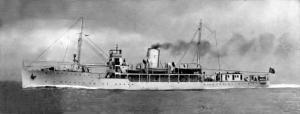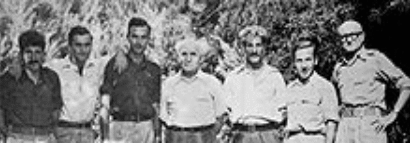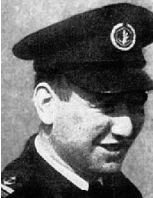
On 22nd October 1948, the Israel Navy performed a feat of great daring and resourcefulness. Paul Shulman, a Machalnik from the U.S.A, was Commander of the Israel Navy at that time.
For some days, a flotilla of Egyptian vessels had been approaching Israel’s southern coastline. The flotilla included the flagship of the Egyptian Navy, the “Emir Farouk.” For several days the navies of Israel and Egypt had been acting in a threatening manner, which was liable to escalate at any time. This mini-escalation took place amidst the largest IDF offensive of the war, “Operation Yoav,” the first of four major Israeli advances into the Negev, all the way down to Eilat and the Red Sea. The “Emir Farouk’s” actions were seen as a threat to ”Operation Yoav” and the IDF General Staff ordered action. The “Emir Farouk” was to be sunk.
This would not be an easy operation. The “Emir Farouk” moved about with two ships for escort, including a minesweeper, and both usually stayed within the protective range of coastal batteries. The small Israel Navy could not sink it with conventional methods. A small assault force would have to be found, and it was – a specially trained group of naval commandos led by Yochai Bin-Nun would undertake the operation.
Yochai Bin-Nun was born in Haifa in 1924 and volunteered for service in the Haganah at an early age. By 1942, at the age of 18, he was already a recognized figure in the Palmach – the elite strike force of the Haganah – serving in the Upper Galilee and the JezreelValley. He turned out to be one of the most capable infantry squad leaders in the Palmach, noted for his prowess as “a sapper with a keen knowledge of explosives.” He was to trade his land-based service for underwater operations. He would remain in the Israel Navy for the next thirty years, rising to the rank of commander.
The Israel Navy’s sabotage unit that sank the Egyptian flagship “Emir Farouk” near Gaza. From left to right: Zalman Abramov, Yohai Bin-Nun (commander), Ya’akov Reitov, David Ben-Gurion (Prime Minister), Ya’akov Vardi, Yitzhak Brockman, Ya’akov Dori (Chief of Staff).
Trained to deal with the freezing cold and to swiftly and silently approach their targets, Yochai Bin-Nun’s crews were the obvious choice to perform the operation against the “Emir Farouk.” Prime Minister Ben-Gurion’s approval of the proposed sinking was obtained and this news was quickly relayed to the wireless set on the mother ship, the “Maoz,“ which they would be using to launch the four human torpedoe boats.
Shulman decided on a night attack, positioning the “Maoz” between the Egyptian ships and the moon. As darkness fell, the “Maoz” crew lowered four small vessels into the water. These four specially designed craft were filled with explosives which were intended to carry their operator to within 100-yards of their target. From there, the operator would aim his craft at the enemy ship, and send it speeding off towards its target, and then seconds later, jump out, his legs attached to a flotation device. The craft worked something like a torpedo. It took them nearly an hour to reach the Egyptian ships.
The four boats assembled for action. The first one took aim, fired, and the operator was ejected well before it struck the “Emir Farouk” and detonated. The operator was safe, and the “Emir Farouk” was now badly damaged, but not destroyed. A second boat opted to have another go at the “Emir Farouk.” The impact and detonation broke the ship in two. Minutes later, it sank.
This was a tremendous feat for the young Israel Navy. But the minesweeper still remained afloat, and the Egyptian soldiers aboard began firing wildly in all directions in the hope of hitting something. Yochai Bin-Nun was determined to take out the minesweeper. He positioned himself for a headlong rush at the ship. As he did so, a high-power Egyptian searchlight illuminated his boat and the Egyptians focused their fire on him.
Bin-Nun ejected his flotation device but it simply would not eject. He was stuck. Faced with the prospect of being neck-high in water and about to absorb a 300-kilogram blast did not suit him, and neither did driving his boat straight into the mine-sweeper’s hull. He tried to free himself manually when he was 100-meters from his target, but the lever wouldn’t give, so he pulled until the handle snapped. When he was 40-meters away from the minesweeper he jumped, still attached to his boat. Finally, at 30-meters from his target he managed to free himself, just a few seconds before his boat scored a direct hit on the minesweeper, sending it to the bottom of the sea.
Bin-Nun and his three operators were picked up in the water and taken safely back to base. They had accomplished an incredible mission. The“Emir Farouk” had been carrying over 500 Egyptian soldiers who were to serve as reinforcements for the Egyptian Army in Gaza.
|
|
In the aftermath, Egypt complained to the U.S. State Department that an American citizen had sunk its navy’s flagship, and the State Department asked Shulman to resign his naval reserve commission. |
RESEARCH SUPPLEMENT:
In addition to Paul Shulman, Commander of the Navy aboard the “Josiah Wedgwood,” there were Machalniks from various countries serving on the ships involved in the sinking of the “Emir Farouk” – British, Americans, Canadians, South Africans, Scandinavians and others.¹
On the “Maoz” (formerly the “Ben Hecht,” formerly the “Abril”), orders were given in three languages, Hebrew, English, and French. Cyril Gotsman (South African Machalnik) headed one of the engine-room watches. British Machalniks David Fisher and Bernard Rosen were also on board.
The former sub-chaser “Noga” was commanded by half-Dutch, half-Malaysian, ex-Royal Dutch Navy Avram Pizaro. Its bosun, American Aaron Cohen (known as a man who knew no fear) was in charge of its two-inch gun. South African volunteer Charles Mandelstam was in charge of the two 20-mm guns. The “Noga’s” main task was to tempt the Emir Farouk out of Gaza harbor.
South African Frank Herbstein of the Scientific Corps was also on the “Maoz.” His team had been asked to design an instrument to enable Ben-Nun and his bombers to be seen and picked up in the dark. They came up with infra-red lamps attached to women’s bathing caps, which in the end did not’t work. The torpedo men had put on the bathing caps but omitted to button up. The result was that as they jumped into the sea after directing their boats at the targets, the lamps fell off. Luckily, they were also equipped with hand torches.
As the action took place 24-hours after a cease-fire, both sides kept the news a secret. The Egyptians were embarrassed to admit that their flagship had been sunk. The Israelis kept their sailors incommunicado, sailing up and down the coast between Haifa and Tel Aviv for five days.
Researcher’s note:
¹ Machalniks who served on the ships involved in the sinking of the “Emir Farouk:”
|
HAGANAH – K20 |
|
|
CANADA |
Allen Brown, Murray Ginsberg, Moshe Katz, Joe Macillin, Ben Ocupnick, Gerry Rosenberg, Frank Stitz |
|
U.K. |
Monty Bixer |
|
U.S.A. |
David Baum, Arthur Sokol, Saul Twicken |
|
BELGIUM |
Andre Wieder |
|
FINLAND |
Avraham Anker, John Anker, Israel Baran, Harry Milner, Marcus Rung, Theo Salutskij, Moses Strasch, Bjorn Silberstein |
JOSIAH WEDGWOOD – K18 |
|
|
U.K. |
Joseph Brooks, Stanley Summers |
|
NOGA – K26 |
|
|
HOLLAND |
Avram Pizaro |
|
SCOTLAND |
Oscar (Jack) Epstein |
|
U.S.A. |
Marty Gross, Gerry Cohen, Art Braver, Dave Hanowice, Jack Freedland, Arnold Kite, Sid Weinhaus |
|
MAOZ |
|
|
SOUTH AFRICA |
Cyril Gotsman, Frank Herbstein |
|
U.K. |
David Fisher, Bernard Rosen |
Sources: Various, including the Jewish Agency, Wikipedia websites, Henry Katzew’s “South Africa’s 800” and Machal records.



